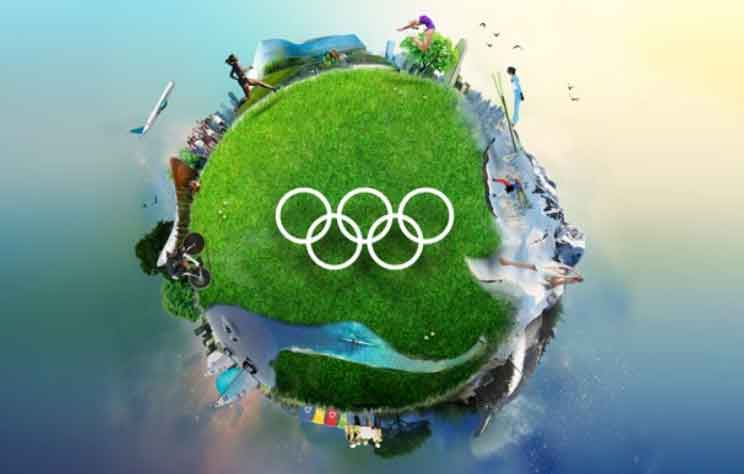Dr. N. Munal Meitei,
Environmentalist. email -nmunall@yahoo.in

Paris Olympic Game, the biggest sport extravaganza is going on from 26 July to 11 August 2024. The first records of the Games are from around 778 B.C. in Ancient Greece but modern day Olympics were reconstructed by Baron Peirre De Coubertin in Athens on April 6, 1896. It is the dream of every athlete to crown with Olympic medals and for every nation to host the Olympics. Hosting the Olympics has the potential to boost tourism, create better sporting facilities, improve transportation, develop infrastructure, create more jobs and increase economic growth. Unfortunately, the environmental impact of these games is often ignored. International Olympic Committee (IOC) always stresses on protecting the environment as a top priority but actions always lie on table. Two recent Olympics – Tokyo and Beijing – have shown how the pledge to keep environment a priority was gone by the wayside.
Climate Scientists cannot fully document all the carbon emissions from the Olympics – but in fact, the impact is far too large. The Paris organizers assure to keep these Games within a budget of 1.58 million metric tons of CO2 equivalent – the same warming impact as driving 376,000 cars for a year. Large scale efforts include the use of 95% preexisting venues and 100% of venues being grid-connected with renewable energy. Moreover, four of every five Paris 2024 venues sit within a 10 km radius and took less than 30 minutes.
To limit their carbon footprint, organizers also aims for zero food waste by procuring 80% of ingredients from local sources – thereby limiting “food miles” and reducing animal products by 60% and double the amount of plant-based products on the menu.
The Tokyo Olympic-2020 was the first to truly make the environment a legitimate priority. IOC announced that by 2030, the Olympic Games will be climate-positive, not just climate neutral. Organizing committees should minimize and compensate for their direct and indirect emissions and implement zero-carbon solutions for the Olympic Games and beyond. One solution would be to pick host cities with the necessary facilities to hold every event to eliminate the need to construct large new facilities. However, this would prevent many countries from showcasing themselves to the world.
Organizers claim that Paris Olympic will be “a historic and revolutionary for the climate.” But in COP21 (2015), held in this very city, the world agreed to limit global warming to 1.5°C. It’s too late for Paris, but if the organizers truly want, the Games need to reduce their size, limit the number of tourists. Until then, the Olympic is a green-wash, a pale bit of lip service.
IOC is one of the largest culprits of green-washing in the sporting world. One IOC sponsor, Coca-Cola, is the world’s biggest producer of plastic waste. Another sponsor, Toyota, was hit with a Rs.15030 million fine for consistently violating the Clean Air Act. A third, Samsung, was singled out by the New Climate Institute and Carbon Market Watch for its green-washing.
The Paris Olympic Games is an example of what big sporting events can do to reduce their impact on the environment and promote sustainability solutions to a global audience. Spectators will experience sustainability firsthand and organizers will promote the Games’ sustainability efforts thereby influencing people’s everyday behaviors.
Studies have shown that the Olympics have become more harmful to the environment as they’ve expanded in size and scale. The last two summer Olympic Games held in Tokyo, Japan and Rio de Janeiro, Brazil released more than 2.7 million and 4.5 million tons of carbon respectively. More athletes, spectators, events and venues emit more carbon and consume more natural resources. Olympics-related construction has also reshaped ecological landscapes and displaced many residents. In addition, the Olympics are increasingly hosted by countries where renewable infrastructure and environmental protections are less established.
Scientists expect the number of cities able to host the Olympics will decrease considerably as the planet warms. One study found that by 2080, an increase in temperatures would make, only 8 of the past 21 cities to host the Winter Olympics would be able to do so again. By 2085, only an estimated 5% of currently viable cities in the Northern Hemisphere would be considered cool enough for athletes.
Prior to 1956 the Olympic host cities were chosen based on the capability of infrastructure. To gain, the bidding countries were extortionate in spending between Rs. 422 billion to Rs. 4215 billion on infrastructure upgradation. Moreover, many of the venues are left abandoned and unused after the Games are over.
Olympic occupies a special place in modern life to promote health, inspire patriotism and it does not have the boundaries between the caste, creed and the religions. Sport can now bring a positive force for environmental protection by adopting sustainable practices.
As per IOC, Environment deserves to be the third pillar of Olympism, after Sport and Culture. IOC committed to reduce its greenhouse gas emissions by 30% in 2024 and 45% by 2030. And more than 100% of the remaining carbon emissions will be offset through the Olympic Forest, a project to plant 355000 trees over an area of 2120 hectares in Mali and Senegal.
The relationship between Olympics and environment emerged in 1994 when the United Nations Environment Program and IOC began working together to reduce the environmental impacts of the Olympic and Paralympic games. Today, interest in the environment is now at the center of management debates to draw attention to the strengthening of the relationship between sports and the environment.
The sports industry is one of the most important actors in global environmental pollution. To take this dangerous process under control, strategic management skills and new policies must be developed in sports, because environmental threats are increasing due to the intense interest in sports worldwide.
The Olympics organizers should invest on green electricity to reduce costs in the long-term and to encourage more environments friendly including using public transports. In the end, it is important to note that all aspects of Olympics have a link with the natural environment. Thus, we can’t set aside Olympics and also the environment for the human survival. When we join the natural environment and Olympics, it can shape for a beautiful planet.













